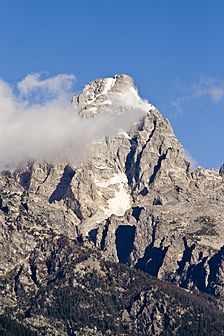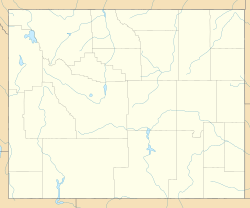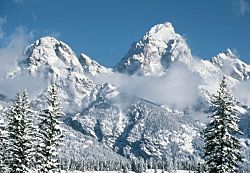Grand Teton facts for kids
Quick facts for kids Grand Teton |
|
|---|---|

Grand Teton from the southeast
|
|
| Highest point | |
| Elevation | 13,775 ft (4,199 m) NAVD 88 |
| Prominence | 6,530 ft (1,990 m) |
| Parent peak | Gannett Peak |
| Listing |
|
| Geography | |
| Country | United States |
| State | Wyoming |
| County | Teton |
| Parent range | Teton Range |
| Protected area | Grand Teton National Park |
| Topo map | USGS Grand Teton, WY |
| Climbing | |
| First ascent | 1872 or 1898. See Who first climbed Grand Teton? |
| Easiest route | Climb, class 5.4. |
Grand Teton is the tallest mountain in Grand Teton National Park, located in Northwest Wyoming. It is a very popular spot for mountaineering in America.
Contents
Where is Grand Teton Located?
Grand Teton stands at 13,775 feet (4,199 meters) tall. It is the highest point in the Teton Range. It is also the second highest peak in Wyoming, right after Gannett Peak.
This mountain is part of the Snake River drainage basin. This means that water from its glaciers and creeks flows into the Snake River. The Teton Range is a smaller part of the larger Rocky Mountains. The Rocky Mountains stretch from northern British Columbia in Canada all the way to northern New Mexico in the United States.
What is the Weather Like on Grand Teton?
The weather on Grand Teton changes a lot with the seasons. Winters are very cold with lots of snow. Summers are milder, but still cool at high elevations.
| Climate data for Grand Teton 43.7404 N, 110.8023 W, Elevation: 12,352 ft (3,765 m) (1991–2020 normals) | |||||||||||||
|---|---|---|---|---|---|---|---|---|---|---|---|---|---|
| Month | Jan | Feb | Mar | Apr | May | Jun | Jul | Aug | Sep | Oct | Nov | Dec | Year |
| Mean daily maximum °F (°C) | 18.5 (−7.5) |
17.7 (−7.9) |
22.4 (−5.3) |
27.3 (−2.6) |
36.8 (2.7) |
47.8 (8.8) |
58.0 (14.4) |
57.1 (13.9) |
48.3 (9.1) |
35.6 (2.0) |
23.9 (−4.5) |
17.9 (−7.8) |
34.3 (1.3) |
| Daily mean °F (°C) | 9.1 (−12.7) |
7.4 (−13.7) |
11.6 (−11.3) |
16.0 (−8.9) |
24.9 (−3.9) |
34.8 (1.6) |
43.7 (6.5) |
43.0 (6.1) |
34.9 (1.6) |
24.0 (−4.4) |
14.5 (−9.7) |
8.7 (−12.9) |
22.7 (−5.1) |
| Mean daily minimum °F (°C) | −0.4 (−18.0) |
−2.9 (−19.4) |
0.8 (−17.3) |
4.6 (−15.2) |
13.0 (−10.6) |
21.8 (−5.7) |
29.5 (−1.4) |
28.8 (−1.8) |
21.6 (−5.8) |
12.3 (−10.9) |
5.2 (−14.9) |
−0.4 (−18.0) |
11.2 (−11.6) |
| Average precipitation inches (mm) | 9.85 (250) |
7.74 (197) |
7.84 (199) |
7.10 (180) |
6.46 (164) |
4.23 (107) |
1.33 (34) |
1.87 (47) |
3.09 (78) |
4.92 (125) |
7.82 (199) |
9.22 (234) |
71.47 (1,814) |
| Source: PRISM Climate Group | |||||||||||||
History of Grand Teton
The history of Grand Teton includes how it got its name and who first climbed it.
How Did Grand Teton Get its Name?
The name "Grand Teton" was first written down as Mount Hayden in 1870. However, the name "the Grand Teton" was already commonly used. By 1931, the name Grand Teton Peak was so popular that the USGS officially recognized it. In 1970, the name was shortened to just Grand Teton on maps.
The most common story about the name is that French-Canadian or Iroquois explorers gave it. Some people wrongly think it was named after the Teton Sioux tribe. But this tribe lived far away, about 200 miles (320 km) from the mountain. Studies show that the tribe's name is not connected to the mountain's name.
Who First Climbed Grand Teton?
There is a long-standing debate about who was the first to reach the top of Grand Teton.
- 1872 Claim: Nathaniel P. Langford and James Stevenson said they climbed it on July 29, 1872. But some experts believe their descriptions and drawings actually match a smaller nearby peak called The Enclosure. The Enclosure has a rock wall built by Native Americans on its top.
- 1898 Ascent: Most people agree that William O. Owen, Franklin Spalding, Frank Peterson, and John Shive definitely reached the summit in 1898. They found no cairn (a pile of rocks often built by climbers) on the true summit, which was unusual if Langford and Stevenson had been there.
Mountaineer and writer Leigh Ortenburger looked into this argument very closely. He concluded that it's hard to prove who was first. He wrote that Langford and Stevenson may have climbed it in 1872. He also said that Kieffer, Newell, and Rhyan may have climbed it in 1893. But he stated that Spalding, Owen, Peterson, and Shive definitely succeeded in 1898.
First Ski and Snowboard Descents
People have also skied and snowboarded down Grand Teton. Here are some of the first descents:
- First male ski descent: Bill Briggs in 1971.
- First female ski descent: Kristen Ulmer in 1997.
- First male Telemark ski descent: Rick Wyatt in 1982.
- First female Telemark ski descent: A.J. Cargill in 2004.
- First male snowboard descent: Stephen Koch in 1989.
- First female snowboard descent: Dani deRuyter in 2010.
- First male disabled ski descent: Santiago Vega in 2021.
How to Climb Grand Teton
Grand Teton is a popular mountain for climbers. There are several routes to the top.
Owen-Spalding Route
The Owen-Spalding route (II, 5.4) is a common way to climb Grand Teton. Part of this route is very exposed, meaning there are big drops next to you. It's good to have some climbing experience before trying it. However, even people new to climbing sometimes reach the top with guides.
This route is named after William Owen and Franklin Spalding. It starts at the Lower Saddle, which you reach by hiking from the Lupine Meadows Trailhead. The harder, more technical part of the climb begins at the Upper Saddle.
Exum Ridge Routes
- Upper Exum Ridge Route: The Upper Exum Ridge Route (II, 5.5) is very popular. It was first climbed by Glenn Exum, who helped start Exum Mountain Guides. This route has some challenging parts, like the "Friction Pitch," which is considered the hardest section.
- Lower Exum Ridge Route: The direct start of the Exum Ridge using the Lower Exum Ridge Route (III, 5.7) is a famous climb. It is even featured in a well-known climbing book called Fifty Classic Climbs of North America.
Other Classic Climbing Routes
Grand Teton has more routes listed in Fifty Classic Climbs of North America than any other peak. This shows how important it is to the climbing community. Other famous routes include:
- The North Ridge (IV, 5.8)
- The North Face with Direct Finish (IV, 5.8)
Since Grand Teton was first climbed, 38 different routes with 58 variations have been created.
Skiing Down Grand Teton
People have also skied down Grand Teton using five different routes. Each of these routes requires at least one rappel (using ropes to lower yourself down).
The first person to ski down the mountain was Bill Briggs in the spring of 1971. He skied down the East Face and Stettner Couloir. This route is now called the Briggs Route. He even had to rappel while still wearing his skis!
It is also possible to ski from the top of the saddle between Grand Teton and the Middle Teton all the way down to the valley floor.
See Also
 In Spanish: Grand Teton para niños
In Spanish: Grand Teton para niños
- 4000 meter peaks of North America
- Central Rocky Mountains
- Mountain peaks of North America
- Mountain peaks of the Rocky Mountains
- Mountain peaks of the United States
- List of Ultras of North America
- List of Ultras of the United States
- Geology of the Grand Teton area



